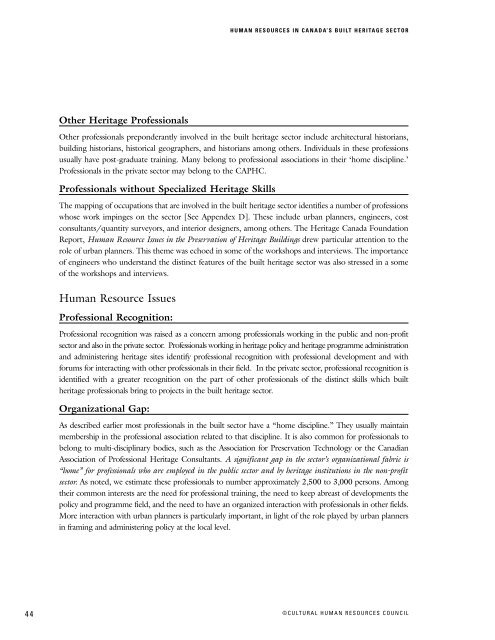Human Resources in Canada's Built Heritage Sector: Mapping the ...
Human Resources in Canada's Built Heritage Sector: Mapping the ...
Human Resources in Canada's Built Heritage Sector: Mapping the ...
- No tags were found...
Create successful ePaper yourself
Turn your PDF publications into a flip-book with our unique Google optimized e-Paper software.
HUMAN RESOURCES IN CANADA’S BUILT HERITAGE SECTORO<strong>the</strong>r <strong>Heritage</strong> ProfessionalsO<strong>the</strong>r professionals preponderantly <strong>in</strong>volved <strong>in</strong> <strong>the</strong> built heritage sector <strong>in</strong>clude architectural historians,build<strong>in</strong>g historians, historical geographers, and historians among o<strong>the</strong>rs. Individuals <strong>in</strong> <strong>the</strong>se professionsusually have post-graduate tra<strong>in</strong><strong>in</strong>g. Many belong to professional associations <strong>in</strong> <strong>the</strong>ir ‘home discipl<strong>in</strong>e.’Professionals <strong>in</strong> <strong>the</strong> private sector may belong to <strong>the</strong> CAPHC.Professionals without Specialized <strong>Heritage</strong> SkillsThe mapp<strong>in</strong>g of occupations that are <strong>in</strong>volved <strong>in</strong> <strong>the</strong> built heritage sector identifies a number of professionswhose work imp<strong>in</strong>ges on <strong>the</strong> sector [See Appendex D]. These <strong>in</strong>clude urban planners, eng<strong>in</strong>eers, costconsultants/quantity surveyors, and <strong>in</strong>terior designers, among o<strong>the</strong>rs. The <strong>Heritage</strong> Canada FoundationReport, <strong>Human</strong> Resource Issues <strong>in</strong> <strong>the</strong> Preservation of <strong>Heritage</strong> Build<strong>in</strong>gs drew particular attention to <strong>the</strong>role of urban planners. This <strong>the</strong>me was echoed <strong>in</strong> some of <strong>the</strong> workshops and <strong>in</strong>terviews. The importanceof eng<strong>in</strong>eers who understand <strong>the</strong> dist<strong>in</strong>ct features of <strong>the</strong> built heritage sector was also stressed <strong>in</strong> a someof <strong>the</strong> workshops and <strong>in</strong>terviews.<strong>Human</strong> Resource IssuesProfessional Recognition:Professional recognition was raised as a concern among professionals work<strong>in</strong>g <strong>in</strong> <strong>the</strong> public and non-profitsector and also <strong>in</strong> <strong>the</strong> private sector. Professionals work<strong>in</strong>g <strong>in</strong> heritage policy and heritage programme adm<strong>in</strong>istrationand adm<strong>in</strong>ister<strong>in</strong>g heritage sites identify professional recognition with professional development and withforums for <strong>in</strong>teract<strong>in</strong>g with o<strong>the</strong>r professionals <strong>in</strong> <strong>the</strong>ir field. In <strong>the</strong> private sector, professional recognition isidentified with a greater recognition on <strong>the</strong> part of o<strong>the</strong>r professionals of <strong>the</strong> dist<strong>in</strong>ct skills which buil<strong>the</strong>ritage professionals br<strong>in</strong>g to projects <strong>in</strong> <strong>the</strong> built heritage sector.Organizational Gap:As described earlier most professionals <strong>in</strong> <strong>the</strong> built sector have a “home discipl<strong>in</strong>e.” They usually ma<strong>in</strong>ta<strong>in</strong>membership <strong>in</strong> <strong>the</strong> professional association related to that discipl<strong>in</strong>e. It is also common for professionals tobelong to multi-discipl<strong>in</strong>ary bodies, such as <strong>the</strong> Association for Preservation Technology or <strong>the</strong> CanadianAssociation of Professional <strong>Heritage</strong> Consultants. A significant gap <strong>in</strong> <strong>the</strong> sector’s organizational fabric is“home” for professionals who are employed <strong>in</strong> <strong>the</strong> public sector and by heritage <strong>in</strong>stitutions <strong>in</strong> <strong>the</strong> non-profitsector. As noted, we estimate <strong>the</strong>se professionals to number approximately 2,500 to 3,000 persons. Among<strong>the</strong>ir common <strong>in</strong>terests are <strong>the</strong> need for professional tra<strong>in</strong><strong>in</strong>g, <strong>the</strong> need to keep abreast of developments <strong>the</strong>policy and programme field, and <strong>the</strong> need to have an organized <strong>in</strong>teraction with professionals <strong>in</strong> o<strong>the</strong>r fields.More <strong>in</strong>teraction with urban planners is particularly important, <strong>in</strong> light of <strong>the</strong> role played by urban planners<strong>in</strong> fram<strong>in</strong>g and adm<strong>in</strong>ister<strong>in</strong>g policy at <strong>the</strong> local level.44©CULTURAL HUMAN RESOURCES COUNCIL










